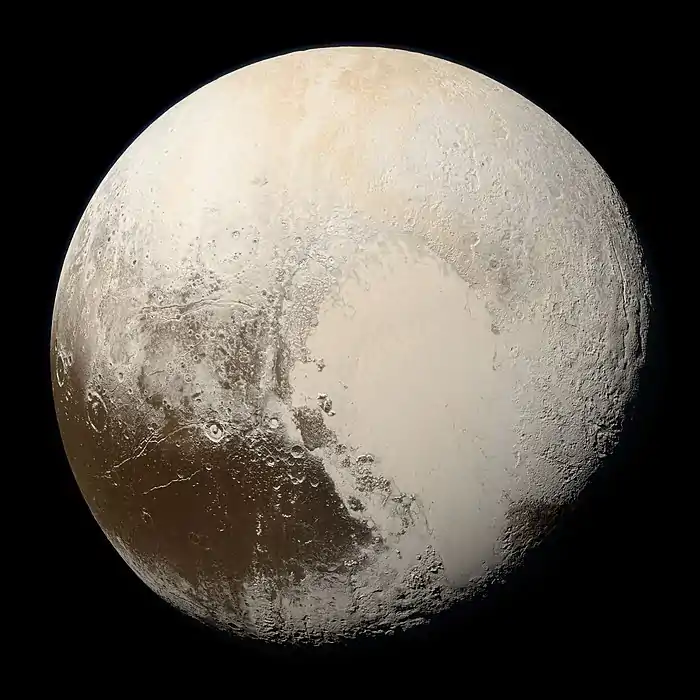| Discovery[1] | |
|---|---|
| Discovered by | Pan-STARRS 1 |
| Discovery site | Haleakala Obs. |
| Discovery date | 4 August 2010 |
| Designations | |
| (523643) 2010 TY53 | |
| 2010 TY53 | |
| TNO[2] · centaur[3][4] distant[1] | |
| Orbital characteristics[2] | |
| Epoch 27 April 2019 (JD 2458600.5) | |
| Uncertainty parameter 2 | |
| Observation arc | 13.24 yr (4,835 d) |
| Aphelion | 56.586 AU |
| Perihelion | 21.066 AU |
| 38.826 AU | |
| Eccentricity | 0.4574 |
| 241.93 yr (88,365 d) | |
| 324.76° | |
| 0° 0m 14.76s / day | |
| Inclination | 22.461° |
| 111.23° | |
| ≈ 13 December 2042[5] | |
| 3.4361° | |
| Physical characteristics | |
Mean diameter | 321 km[3] 329 km[6] |
| n.a.[7] | |
| 0.08 (est.)[6] 0.09 (est.)[3] | |
| 5.7[1][2] 5.8[6] | |
(523643) 2010 TY53, provisional designation 2010 TY53 is a trans-Neptunian object and possible centaur located in the outermost region of the Solar System. With an absolute magnitude of 5.7, it approximately measures 325 kilometers (200 miles) in diameter. It was discovered on 4 August 2010 by the Pan-STARRS-1 survey at the Haleakala Observatory, Hawaii, in the United States.[1] According to American astronomer Michael Brown, it is "possibly" a dwarf planet.[6]
Orbit and classification
2010 TY53 orbits the Sun at a distance of 21.1–56.6 AU once every 241 years and 11 months (88,365 days; semi-major axis of 38.83 AU). Its orbit has an eccentricity of 0.46 and an inclination of 22° with respect to the ecliptic.[2] The body's observation arc begins with a precovery at Palomar Observatory in October 2004, or almost six years prior to its official discovery observation by Pan-STARRS.[1]
Numbering and naming
This minor planet was numbered by the Minor Planet Center on 25 September 2018 (M.P.C. 111778).[8] As of 2018, it has not been named.[1]
Physical characteristics
Diameter and albedo
According to the Johnston's archive and to Michael Brown, 2010 TY53 measures 321 and 329 kilometers in diameter, based on an absolute magnitude of 5.7 and 5.8 and an assumed standard albedo of 0.09 and 0.08 for the body's surface, respectively.[3][6] As of 2018, no physical characteristics have been determined from photometric observations. The body's rotation period, pole and shape remain unknown.[2][7]
References
- 1 2 3 4 5 6 "523643 (2010 TY53)". Minor Planet Center. Retrieved 8 October 2018.
- 1 2 3 4 5 "JPL Small-Body Database Browser: 523643 (2010 TY53)" (2018-01-02 last obs.). Jet Propulsion Laboratory. Retrieved 8 October 2018.
- 1 2 3 4 Johnston, Wm. Robert (30 December 2017). "List of Known Trans-Neptunian Objects". Johnston's Archive. Retrieved 9 February 2018.
- ↑ "List Of Centaurs and Scattered-Disk Objects". Minor Planet Center. Retrieved 9 February 2018.
- ↑ JPL Horizons Observer Location: @sun (Perihelion occurs when deldot changes from negative to positive. Uncertainty in time of perihelion is 3-sigma.)
- 1 2 3 4 5 Brown, Michael E. "How many dwarf planets are there in the outer solar system?". California Institute of Technology. Retrieved 9 February 2018.
- 1 2 "Asteroid (523643) 2010 TY53". Small Bodies Data Ferret. Retrieved 8 October 2018.
- ↑ "MPC/MPO/MPS Archive". Minor Planet Center. Retrieved 8 October 2018.
External links
- Discovery Circumstances: Numbered Minor Planets (520001)-(525000) – Minor Planet Center
- (523643) 2010 TY53 at AstDyS-2, Asteroids—Dynamic Site
- (523643) 2010 TY53 at the JPL Small-Body Database
_(cropped).jpg.webp)
